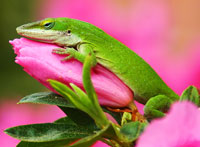By Russ Case
Click image to enlarge Is the anole the true Lizard King? |
For many years, especially back in the early 1990s, the green iguana was an immensely popular lizard pet and was often touted as the Lizard King. It still is popular, but in recent years the bearded dragon is usually touted as the number one lizard pet, with the leopard gecko up there, too. Whenever anyone is talking about a number one lizard pet, though, I often wonder where the anole fits in and whether or not it is the true Lizard King. Let’s face it, the common green anole (Anolis carolinensis), because it’s quite inexpensive compared to bearded dragons, leopard geckos and other species, is the lizard that still kicks off many a person’s reptilekeeping interests, and it remains a pet store mainstay.
My first lizard pets were green anoles. They were likely also my first escapees. As I may have mentioned in a past blog (or not – it’s getting hard to keep track in my head, and at the moment I’m too lazy to go back and check the archives) I once had one escape and turn up later, wrapped around the neck of a lamp in our basement. Guess what color that lamp was. Green, of course.
Anoles do have color-changing abilities, but they’re not really that spectacular. Their standard green is hard to improve upon anyway. Although they have been erroneously referred to as “chameleons,” they belong to an entirely different group of lizards, and they have nowhere near the impressive color-changing talents as true chameleons such as panther chameleons. They basically lighten up when they’re warm and darken when they’re cool. Their shades of color can also reflect their mood at the time; an angry male anole that is feeling territorial toward another male may also darken in color. Male green anoles do have a colorful purplish dewlap that looks really cool when it’s extended, which they will exhibit during territorial or mating displays.
Territoriality is an issue with male anoles, so only one male per enclosure is usually recommended. He can be kept with a couple/few females. If you have a really large enclosure that would permit multiple males to set up their own territories you could try keeping more than one together. Chances are, however, that they will still fight, and that could lead to injury. Try keeping multiple male anoles together at your own risk.
The office reaction to Helmut, my rescued red-eared slider, has been positive, and I’ve been thinking about trying to get a few different reptile and amphibian species in here. Anoles are fairly easy to maintain in captivity, and because of that, I’ve been toying with the idea of setting up a 35-gallon hexagonal vivarium in my office. I’ve got an empty aquarium fitting that description in my garage right now and thought it would be neat to install some live plants in it along with a few green anoles. When keeping animals here I need easy-to-care for species. Anoles are that, plus they’re attractive, active, diurnal lizards. A setup such as I’m imagining would be perfect for them.
It’s fun to witness the interest my co-workers exhibit when they come upon reptiles. Don’t think every editor on every magazine we publish (more than 50 titles) is a reptile enthusiast. I enjoy teaching people here who don’t know about reptiles. I’ve wanted to get some bearded dragons, too – they’re great reptile ambassadors, after all — but they would need a larger enclosure than I can provide at the moment. Maybe someday I’ll remove my desk to make space. Having that out of here would probably make my job a lot easier — or maybe nonexistent, now that I think of it.
Anyway, I’m pretty sure there are anoles in my office’s future. Providing the proper temperature gradient between room temperature and 90 degrees should not be a problem, and neither should maintaining the proper humidity level via misting with purified water (to avoid unsightly hard-water deposits from speckling the enclosure’s glass walls). I envision an enclosure that will be eye-catching with live plants, branches, the anoles…maybe even a frog or two.
Let the planning begin!


